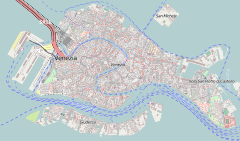Tolentini, Venice
| Church of San Nicolò da Tolentino | |
|---|---|
 Facade on Campo dei Tolentini. | |
| Religion | |
| Affiliation | Roman Catholic |
| Province | Venice |
| Location | |
| Location | Venice, Italy |
| Geographic coordinates | 45°26′15″N 12°19′20″E / 45.4374°N 12.3221°E |
| Architecture | |
| Architect(s) | Vincenzo Scamozzi and Andrea Tirali |
| Type | Church |
| Completed | 1714 |

The Chiesa di San Nicolò da Tolentino, commonly known as the Tolentini, is a church in the sestiere of Santa Croce in Venice, northern Italy. It lies in a Campo of the same name and along the Rio dei Tolentini, near the Giardino Papadopoli.
History
The Theatines arrived in Venice in 1527 after the Sack of Rome. The church dedicated to Saint Nicholas of Tolentino was begun in 1590 by Vincenzo Scamozzi.[1] The relationship between Scamozzi and his patrons was stormy, and the church was finally completed only in 1714. It is a large church with a huge freestanding Corinthian portico, the only one in Venice, designed by Andrea Tirali.
The Tolentini is a parish church of the Vicariate of San Polo-Santa Croce-Dorsoduro. The church contains the tomb of Doge Giovanni I Corner, Francesco Corner, Giovanni II Corner, and Paolo Renier. The baroque organ was constructed by Pietro Nacchini in 1754.
Annexed to the church was the monastery, now site of the architecture university of Ca’ Foscari.[1] In 1966 Carlo Scarpa worked on creating an entrance for the institute.[2]
Works of art
- San Nicola da Tolentino
- Ceiling by Mattia Bortoloni
The high altar is by Baldassare Longhena. In 1627, Johann Liss painted a large altarpiece, the Inspiration of Saint Jerome to the left of chancel.[3][4] In 1629 Bernardo Strozzi painted St Lawrence Giving Alms for the chancel.[5]
The funereal monument of the Patriarch of Venice, Giovan Francesco Morosini (d.1678) in the chancel, was completed by the Genovese sculptor Filippo Parodi.[6]
References
- ^ a b "Church of San Nicola da Tolentino", Camera di Commercio di venezia
- ^ Plant, Margaret. Venice: Fragile City, 1797-1997, Yale University Press, 2002, p. 348 ISBN 9780300083866
- ^ Inspiration of St Jerome
- ^ Wittkower, Rudolf and Wittkower, Margot. Born Under Saturn: The Character and Conduct of Artists, New York Review of Books, 2006, p. 56 ISBN 9781590172131
- ^ The Charity of St Lawrence
- ^ Barzazi, Antonella (2012). "Morosini, Giovan Francesco". Dizionario Biografico degli Italiani, Volume 77: Morlini–Natolini (in Italian). Rome: Istituto dell'Enciclopedia Italiana. ISBN 978-8-81200032-6.




